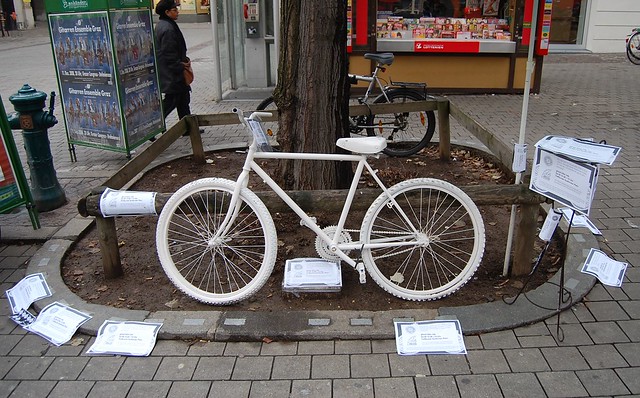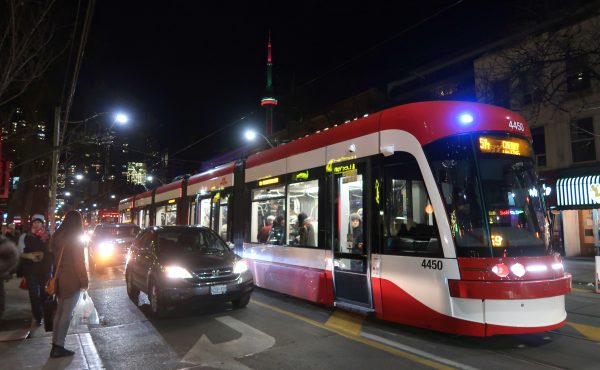

• There is a tradition amongst cycling advocates around the world to attach a “ghost bike” — every part of it painted solid white — to a light pole or bike rack in order to memorialize the death of a cyclist near that location. New York City is considering a law that would allow the city to remove these bikes.
• The Guardian reports, “Much has been written about a war between cyclists and drivers, as if the two groups were such polar opposites that they could never cross in a Venn diagram. But according to new research, people who cycle the most are likely to own at least two cars.”
• High-speed rail is a hot topic south of the border, especially along the densely populated east coast. The Philadelphia Inquirer has compiled a handful of their articles on the topic into one easy-to-read section.
• “The controversial Cincinnati streetcar plan may have made its final political stop at City Hall on Wednesday, when City Council authorized moving ahead with $108 million in grants and bonds for a project that has dominated civic debate for the past three years. In a series of 5-3 votes mirroring the action of council’s budget committee earlier this week, council gave city administrators approval to proceed with $44 million in grants and $64 million in bonds that will finance most of the Downtown-to-Uptown streetcar line’s $128 million first phase.”
• The wonderful public transit blog Human Transit has a great post about the need for well-designed, easy-to-understand transit maps. “The process of learning any network — roads or transit or any kind of geography — begins with identifying a few features as major, and then understanding how the other features fit around those. If you’re looking a map of natural geography, you’ll notice the big rivers and mountains before you notice the small ones. If you’re looking at a highway map, you’ll understand the big highways first, and later, only as needed, you’ll study how lesser roads connect with those main highways. Transit customers and potential customers need the same ability to sort the mass of detail presented by a transit network.”
• Forget about playing Mozart when the baby is in the womb — start a school garden instead! Treehugger has a post on a new report from the Royal Horticultural Society has found that when children work in school gardens they develop increased life skills, greater literacy and numeracy and are more responsive to the challenges of adult life.




4 comments
Good for Cincinnati. The streetcar should help them get this huge monkey off their back:
http://en.wikipedia.org/wiki/Cincinnati_Subway
Now, if right-wing-peppered, seriously-segregated, borderline basket-case cities like Cincinnati can get around to building streetcars, why is Transit City such a fight in supposedly sophisticated and streetcar-loving Toronto? Get it done already, and then build more! The evidence of peer cities is all any mayoral candidate should need to understand that Toronto needs to lay more track, fast, in all directions from downtown to airport to suburbs, in order to keep up with the competition.
To be fair, the RHS report does not even come close to proving that school gardens improve literacy and numeracy. I wish it did, because then we would have a school garden in every public school in the US and Canada, but it doesn’t.
It says teachers were able to differentiate instructional approaches in school gardens and that, anecdotately, this resulted in postive learning outcomes for many students in Math, Science, and English. Great, but with the right enthusiastic teacher, you could get these same anecdotal benefits in any new learning context.
It might be a bit of an oversell to say school gardens enhance literacy and numeracy for now–especially when there are so many other less equivocal positive outcomes (interspersonal and behavioural, health and safety, community cohesion) that people won’t roll their eyes at.
Weird – a New Yorker telling us to build streetcar lines and invoking a much smaller city as an example. But after so many dismal failures to build transit lines, they could go nowhere but up. There’s a logical reason why “sophisticated Toronto” isn’t too thrilled about LRT lines, especially considering cases like Sheppard, where the subway already works quite well and no one wants an extra transfer. It just seems stupid. Eglinton might work, but it should be grade separated all grade separated, not just one section.
We already started building a great subway network. Transit City is like starting from zero on a network and setting ourselves back. Early cost estimates are have risen sharply, it hasn’t proven more effective politically and no one likes the divisions ROWs create in streets.
(Unless he was being sarcastic…)
One benefit we’ve noticed in our school gardens is that kids are more willing to try and taste fruits and vegetables – healthy, unpackaged, natural and organic foods available right outside their classroom door.
We figure this makes kids more interested and receptive to those foods in other contexts. And here the research is very compelling. Check http://www.csgn.org/research.php for examples.
Maybe the academic and social benefits are anecdotal, but there’s no evidence that school gardens do any harm in these areas. With epidemic childhood obesity and diabetes, both directly related to eating too much fat, sugar and salt in the fast-food and packaged diet, new strategies for increasing children’s healthy eating and exercise are beginning to gain traction.
Finally, hands-on, experiential learning is more accessible for children who don’t learn well in the traditional desk/paper & pencil environment. Here’s where the academic benefits might be most pronounced. A kid who’s struggling to grasp math or language concepts might need the three-dimensional and real-world context to make connections for her/himself. If s/he enjoys some healthy food or gets a kick out of watching a worm wiggle, the process of learning gets linked to enjoyment rather than struggle in the kid’s brain. Seeing 3000 kids a year get this enjoyment firms my resolve to continue developing the school garden movement, whether grownups roll their eyes or not.